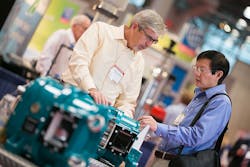Process industries are firmly ensconced in a new millennium at Chem Show
In 1911, Thomas Edison predicted that by the year 2011 the United States of America would be a land of solid gold taxis, incredibly fast electric trains, homes made of steel from basement to attic and books with extremely thin pages made of nickel.
Though some of this now seems far-fetched, Edison clearly had high expectations and regard for a future led by chemists, engineers and scientists.
Edison, along with a few hundred other chemists, engineers and innovators, attended the very first Chem Show in 1915. The inaugural Show focused on chemicals and chemical manufacturing equipment with a special concentration on dyes.
One hundred years later, today’s Chem Show is about more sophisticated chemical process equipment, automation and controls that address an ever-growing need for new technologies and products to mix, heat, cool, filter, move and measure liquids, gases and dry materials more efficiently. Today’s industry professionals look to do more than ever in less time than ever and with fewer resources.
Stability amidst change
One element that hasn’t changed: the location of the Chem Show. As it was in the early 20th century, the majority of America’s CPI is still concentrated on the east coast. Twenty-eight percent of total U.S. chemical production is within 500 miles of New York City. According to the American Chemistry Council, $78 billion each year in chemical production comes from New York, New Jersey and Pennsylvania alone. Additionally, experts project a 3.5 percent average yearly increase in northeast chemical-related production through 2023.
In the past 100 years, the Chem Show survived wars, market fluctuations and deviations, and technological changes unlike anything Edison ever imagined. The show has evolved with a changing industry and world.
Looking back at the first show compared to the one being held later this year, differences include the many technologies evolved or invented, dramatically impacting all facets of the CPI, including electronics, waste treatment and concern for sustainability.
The world in 1915 boasted advancements in machinery including radios, telephones and automobiles. However, the first Chem Show exhibits reflected the fact that all chemical processing and handling equipment at the time was controlled manually. There were no electronic controls or components involved in processing operations.
What a difference 100 years makes. Computers and automation exponentially changed chemical processing in both effectiveness and efficiency. An exhibit at this year’s Chem Show will demonstrate safety instrumented systems (SIS). SIS increase process reliability, reduce lifecycle costs and avoid adverse consequences by automatically putting controls into a "safe state" when operational errors occur.
Specific needs
In 1915, only about 50 percent of all major cities in the U.S. had an official waste collection system in place, not to mention industrial facilities. Waste in general wasn’t a concern or priority until the 1960s or 1970s and a series of toxic chemical waste dumping incidents. Public outcry and negative publicity created a demand for waste treatment processes and facilities.
Today’s Chem Show sees over 25 exhibitors showcasing equipment for waste treatment. The first show saw none. Among equipment shown will be a filter press, a tool used to dewater sludge from purification plants for chemical and pharmaceutical processes. While filter presses are among the oldest machine-driven dewatering devices, companies are constantly working to improve the efficiency of existing equipment. In this case, the filter press is able to dewater larger volumes of sludge than we’ve seen in past models.
And finally, in 1915, energy needs were relatively modest and conservation issues little heeded. The Chem Show has seen energy markets transformed and CPI products change in response. A prime example of this current trend is clarification technologies for filtration, which provide new and creative solutions to process filtration problems. Consequently, these technologies reduce energy wasted by malfunctioning or sluggish machines.
While many things have changed, some stay the same. As the event for processing technology, the Chem Show gives engineers, plant managers and other industry professionals a chance to see the latest equipment, meet product experts and learn about new and better ways to meet production challenges. And in the competitive CPI, this trade show is still one of the best platforms where professionals can find the equipment, technology and resources they need to satisfy the growing demands for increased production and efficiency.
We may not be riding around in golden taxis or living in solid steel houses, but we are carrying on Edison’s spirit of optimism and innovation. There is no telling what the next 100 years will bring as the chemical process industries continue to evolve. Perhaps one of this year’s show participants will be the next great innovator, the Thomas Edison of the 21st century.
The 2015 Chem Show will be held Nov. 17 – 19 at the Javits Center in New York City.
